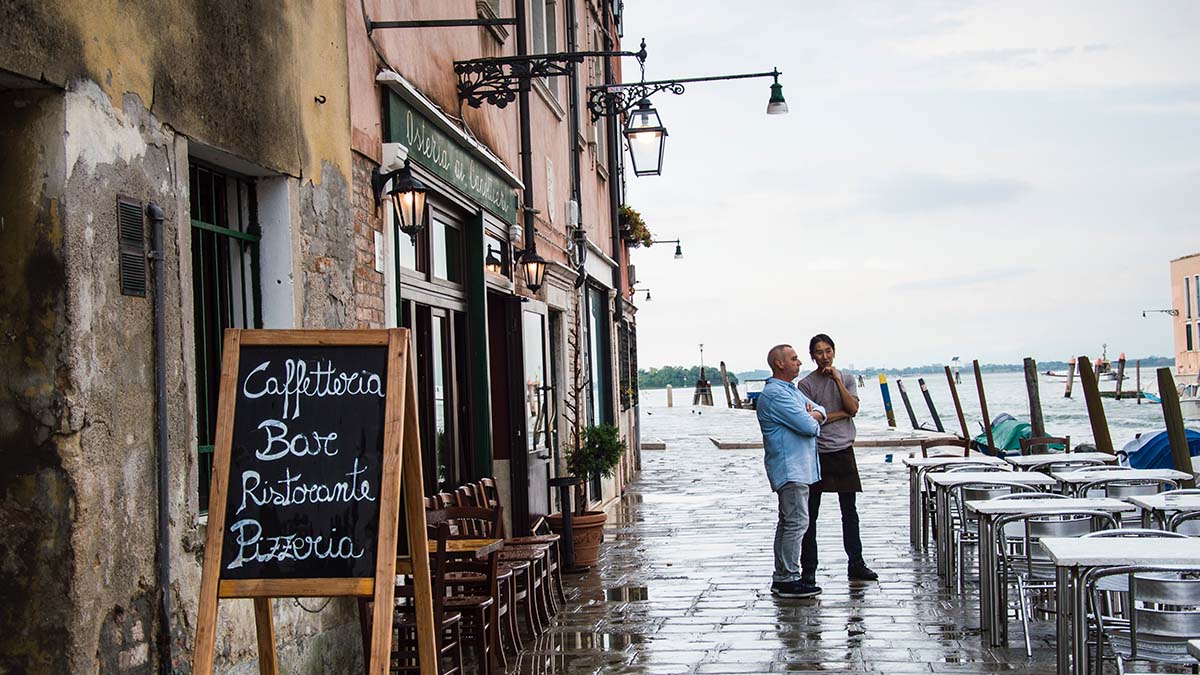
Becoming Italian
by G.G. Husak
When Al and I cross the ocean, we become Italian, at least in our own minds. We let go of our compulsive, time-oriented ways and our distress at the minor inconveniences in our lives and try to just let things happen.
In Italy, life proceeds at its own pace and with its own rhythm. When a hotel manager says that the room will be ready, “In ten minutes,” he doesn’t mean by the clock. He means, “In a little while,” an indeterminate amount of time. Maybe it will be soon but more likely later. Once we accept this, we relax, no longer going back up to the desk every two seconds to find out if the room is ready yet. Now, we leave our bags at the desk and go out for a walk, not caring when the room is ready.
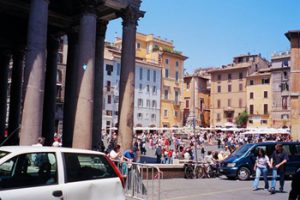 When we arrive, we try as soon as possible to settle into the rhythm of things and become Italian in our reactions. Italian waiters in a touristy outdoor cafe can avoid making eye contact almost indefinitely. We learn that if we just sit and wait, rather than trying, American-style, to get a waiter’s attention, we will get served and probably sooner than if we overact. We get used to things the way they are, adapting to variations from city to city and region to region; we get on Italian time.
When we arrive, we try as soon as possible to settle into the rhythm of things and become Italian in our reactions. Italian waiters in a touristy outdoor cafe can avoid making eye contact almost indefinitely. We learn that if we just sit and wait, rather than trying, American-style, to get a waiter’s attention, we will get served and probably sooner than if we overact. We get used to things the way they are, adapting to variations from city to city and region to region; we get on Italian time.
In Italy things happen soon enough, but there is never a rush. Even in traffic when people are honking their horns, seemingly in a hurry to get around circles and through intersections, much of the intensity seems to be for the sport of it. The beeping and tooting horns are the automobile version of verbal communication rather than driver hostility and road rage that horns often convey back home. Energy is expelled but no harm done.
From our first trips, I have known that our versions of Italy, our sense of the place and of its people, is colored by a romantic notion. This is after all our Italy, not an objective view based on factual research or authentic cultural experience justified by having lived there for years. We are not Italians and not experts on their culture, but only on our subjective experience of it.

Italian business owners don’t seem to need to have constant growth and improvement. More and bigger is not necessarily better. The attitude seems to be: If one restaurant supports the family, provides work and good meals, why expand? And as Al once said, looking around a small trattoria on the ground floor of an old building, “There’s no room to add on anyway.”
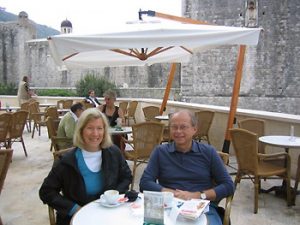 We enjoy becoming Italian in our feeling of familiarity about little things. We know that if we sit at a table in a cafe and have our coffee served to us, it may cost several dollars, but if we stand at the counter, drinking the same coffee without table service, it will be 50 cents. We know that ordering “coffee” or “caffè” will bring us a cup of espresso, rather than American style coffee. If we want a lighter drink, coffee with milk, we order a cappuccino or latte. We know to leave a small coin beside the cup as a tip, even if we are served standing.
We enjoy becoming Italian in our feeling of familiarity about little things. We know that if we sit at a table in a cafe and have our coffee served to us, it may cost several dollars, but if we stand at the counter, drinking the same coffee without table service, it will be 50 cents. We know that ordering “coffee” or “caffè” will bring us a cup of espresso, rather than American style coffee. If we want a lighter drink, coffee with milk, we order a cappuccino or latte. We know to leave a small coin beside the cup as a tip, even if we are served standing.
We are used to seeing loose sugar in a bowl on the bar with a couple of communal spoons, no little bags of sanitized sugar and no sugar substitutes. There is also no mess, no torn wrappers, no empty powdered cream containers, no paper to-go cups and no wooden or plastic stirrers. You get a cup, a saucer and a spoon. Occasionally an office or shop worker from down the block will come in and get a small tray of coffees, presumably for coworkers and leave with a round tray and several ceramic espresso cups. Later they will bring back the empties.
Recently in Rome, I was shocked to see my first ever take-out coffee shop, with a sign advertising cups “to-go.” I guessed they were targeting the tourists. But thinking of the waste of paper and plastic that we have unfortunately come to see as normal in many coffee shops at home, I can’t imagine that Italy would ever go down that road.
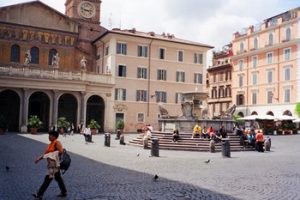 Al and I feel a sense of mastery in knowing the little details about ordering meals. We don’t expect to get water automatically but order it just like the wine. We know that if we don’t ask for water “naturalle” or “senza gas,” without bubbles, we will get mineral water. We are used to paying for a bottle of water rather than assuming water will appear, but the cost will be offset by a $4.00 bottle or carafe of pretty good house wine, which is for us a bargain. We don’t order soft drinks like Coca Cola or Pepsi but recognize fruit drinks like Orangina as the local alternative. Fewer options keep life simpler and encourage a more mindful enjoyment of one’s choice.
Al and I feel a sense of mastery in knowing the little details about ordering meals. We don’t expect to get water automatically but order it just like the wine. We know that if we don’t ask for water “naturalle” or “senza gas,” without bubbles, we will get mineral water. We are used to paying for a bottle of water rather than assuming water will appear, but the cost will be offset by a $4.00 bottle or carafe of pretty good house wine, which is for us a bargain. We don’t order soft drinks like Coca Cola or Pepsi but recognize fruit drinks like Orangina as the local alternative. Fewer options keep life simpler and encourage a more mindful enjoyment of one’s choice.
We know that for counter service, we should remember to pay first for what we want, get a receipt for our sandwich or croissant and cappuccino, and then hand that to the server. Once we got used to this system, we realized it wasn’t about mistrust but has advantages over our reverse approach of eating first and then paying. Deciding and paying first helps the server know exactly what you want before he gives you his attention. You decide what you want, you pay, you get your food and drink, and then you relax. You never have to stand at a cash register, juggling money with your food and drink in hand. And in a station, there is no rush to the check out cashier when the train comes. When it’s time to leave, you leave.
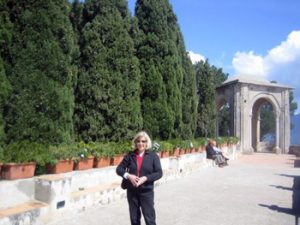 We try to become part of the culture, and connect with people in little ways. We say “Buon giorno,” in the morning, switch to “Buono sera” in the afternoon and occasionally the formal “Buona notte” for good night. Al casually drops first syllables for colloquial use, saying “…sera” to Italians who greet us in the elevator. If someone offers us a candy or cracker on a train, we accept, in spite of our at home injunctions against taking candy from strangers. It’s the custom to be friendly and we learn to share as well.
We try to become part of the culture, and connect with people in little ways. We say “Buon giorno,” in the morning, switch to “Buono sera” in the afternoon and occasionally the formal “Buona notte” for good night. Al casually drops first syllables for colloquial use, saying “…sera” to Italians who greet us in the elevator. If someone offers us a candy or cracker on a train, we accept, in spite of our at home injunctions against taking candy from strangers. It’s the custom to be friendly and we learn to share as well.
Italian-style, we skip breakfast except for coffee and fruit or maybe a roll. Sometimes we follow local custom and eat a big lunch and a small dinner. Sometimes we sit outside near a fountain eating sandwiches near the ripple of water. We don’t feel compelled to wash fruit purchased in the open markets, but do rinse our hands in the public fountains. Following the lead of the Italians around us and the advice of our guidebooks, we drink the water in the public fountain. We have never gotten sick.
We become Italian in spirit and in heart, and less our individual selves, as we happily merge with the culture and enjoy the energy of the present moment. We become one or two among the many in the flow of humanity in the streets and through history. Not just in the crowds walking along the streets but the long passeggiata of the past to the present, the ancients to modern life. It’s humbling for us, but in a good way, and it’s a relief to let go of roles and responsibilities and just participate in the being aspects of life.
Editor’s note: This is an excerpt from ‘Passeggiata: Strolling Through Italy‘.
Book Synopsis:
This travel memoir will appeal to those who love travel in general and Italy in particular. A couple’s journey that is both personal and universal, the author recounts their first shared trip to Italy in 1993 and their annual passeggiata over the next decade. On their spring pilgrimages to major tourist centers, Rome, Florence, Venice, Milan, Naples, they develop appreciation for Italy’s art, music and architecture. Wandering together along out of the way paths in tiny hill towns and seacoast villages, the author and her husband explore breathtaking scenery while marking shifts in their empty nest relationship. By traveling light and learning the vagaries of Italian life, they become Italian in spirit. The book provides many practical hints on how to travel like the locals, reminding us that even novice travelers can learn valuable lessons from immersion in another way of life, and that one’s companion can be an essential part of the pleasure of a journey.
See more about the book on Amazon.
About the author:
Since 1993, Glen Grymes Husak has made an annual pilgrimage to Italy. Glen brings her background and insight as an English teacher and museum docent to the history and art of Italy. The author is currently based in Houston, Texas. www.passeggiataitalia.com
Photo credits:
First Italian trattoria photo by Miglė Vasiliauskaitė on Unsplash
All other photos are by Glen Grymes Husak




Leave a Reply
You must be logged in to post a comment.